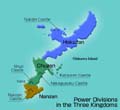|
 According to the histories, King Eiso's monarchy was disrupted and the Ryukyus divided into three spheres of power and influence. This started the Three Kingdoms Period. The king who had succeeded King Eiso to power in the middle kingdom called Chuzan was King Satto. The legend that he was the son of a celestial maid and a poor farmer, born under an extraordinary good fate, gave Satto an air of divinity. According to the histories, King Eiso's monarchy was disrupted and the Ryukyus divided into three spheres of power and influence. This started the Three Kingdoms Period. The king who had succeeded King Eiso to power in the middle kingdom called Chuzan was King Satto. The legend that he was the son of a celestial maid and a poor farmer, born under an extraordinary good fate, gave Satto an air of divinity.
Satto of Chuzan was the proudest of his power among the three kingdoms' rulers. This led him to start relations with Ming Dynasty China as a tributary nation, sending the first tribute ship to the Ming emperor in 1372 AD. Through this the Ryukyus developed a formal trading relationship with China. In return for agreeing to a suzerain relationship under China , King Satto and the other kingdoms' rulers , Sho Satto from the southern kingdom Nanzan and Haniji from the northern kingdom Hokuzan, received recognition from the Emperor of China and legitimized themselves as rulers of their respective nations. In this way China tied the nations of East Asia together in a hierarchy with China at the top. This system was called Sappo and tribute was offered to China by the nations and in return received the honor of trade with the Chinese.
Intense rivalry developed between the kingdoms and they began using castles as their base of operations. The Hokuzan castle was named Nakijin Gusuku, the Chuzan castle was named Urasoe Gusuku and the Nanzan castle was named Shimajiri Ozato Gusuku. From the beginning of the 14th century to the start of the 15th century, the era was called the Sanzan, or Three Kingdoms Period. During this time, trade with other countries increased the economic power of the islands and set the stage for the formation of a united Ryukyu Kingdom.
|

Urasoe Gusuku Castle Site

Nakijin Gusuku Castle Site

Ozato Gusuku Site

Nanzan Gusuku Castle Site
|
![]()